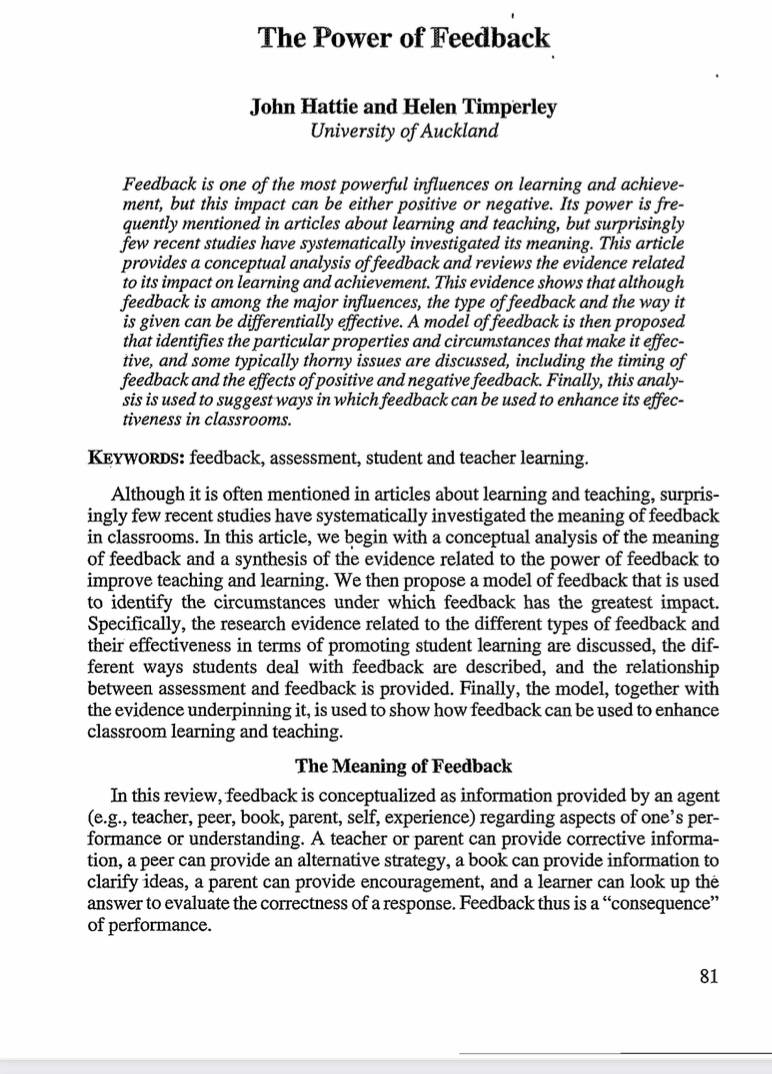ARTICLES ON FEEDBACK
Article one (1)
Nazmillah, Didin Nuruddin Hidayat, Maya Defianty, Anita, and Abdul Muin (2022) study of Teachers Strategies in providingfeedback in English writing class at university of Jakarta Indonesia. The study aims to find out the teachers perspective about feedback in the writing activity in writing class and how teachers provide feedback on students writing activities in the writing class at an English Education Department in a university in Jakarta. The results shows that the Lectures use a combination of indirect-direct feedback and also the combination of writing and oral feedback. Teachers use the feedback according to the condition and the goal of the level of the writing. The combination of oral and writing, direct, and indirect feedback complement each other.
According Nazmillah et al (2022), Every teacher has their idealist to choose appropriate feedback, but the way they deliver the feedback is also important. Because feedback is one medium to help students evaluate their ability, they can improve their ability with feedback. The journal of teaching & Education vol.4 No. 2, 2022.
Nazmillah et al (2022), Self-feedback also develops students' critical awareness of their mistakes in their writing assignments. Therefore, self-feedback pushes students to be more aware of their errors, especially in writing assignments. . The journal of teaching & Education vol.4 No. 2, 2022.
Nazmillah et al (2022), Students can directly reach their errors through direct feedback, and indirect feedback encourages students to learn how to analyze their errors and revise them.The journal of teaching & Education vol.4 No. 2, 2022.
Tehrani (2018), feedback not only shows the correct or the wrong progress of students and the feedback elaborates on the student’s idea and discusses it together. Tehrani, F. A (2018) Feedback for writing or writing for feedback? Journal of Language and Linguistic Studies, 14(4) 162-178.
Nazmillah et al (2022), In the feedback, the teacher's role is important because the correction depends on the teacher's point of view The journal of teaching & Education vol.4 No. 2, 2022.
It stated in Kucukali (2017) stated that a group or individual can conduct feedback, and feedback is classified into Oral, written or virtual feedback.
Based on kucukali (2017), written feedback is explained as the response to student’s performance or assignment through writing comments or suggestion. Kucukali, E. (2017). The Effect of Oral vs. Written Feedback in EFL Writing. Journal of applied Linguistic and Language Research 4(7), 47-67.
And Foozunfar (2018) defined oral feedback as feedback from a teacher, including the interaction between students and teachers.Ashrafi, S,. & Foozunfar (2018). The effect of Oral, Written feedback types on EFL learner’s written accuracy. The relevance of learner’s perception proceeding of the 2nd National Conference on English Language Studies: Applied Linguistic Perspective on EFL, May, 2-22.
Kuyyogsuy (2019), stated that peer feedback is one way toengaged students in showing their ideas and giving and accepting constructive feedback to enhance the writing skills. Kuyyogsuy,S. (2019). Promoting peer feedback in developing students English Writing abilities L2 writing Class. International Education studies 12(9) 76-90.
Ramiraz Balderas and Guillen Cuamatzi (2018) self-feedback is like indirect feedback: teachers give an option and permitstudents to recognized their mistake and correct them by themselves. Ramiraz Balderas, I., & Guillen Cuamatzi, P.M (2018) self and peer correction to improved college students, Writing skills. Profile Issue in Teachers professionalDevelopment, 20(2) 179-194.
Nazmillah et al (2022), When the oral feedback is conducted, it is a perfect time for students to confirm the misunderstanding about the teacher's feedback. Thus, students can be more aware of their weaknesses in their writing. Then, to provide feedback, one lecturer used direct feedback. The lecturer showed the error directly and revised the error. Direct feedback is more precise than indirect feedback. The journal of teaching & Education vol.4 No. 2, 2022.
Michael Herderson, Michael Phillips, Tracii Ryan, David Boud Phillip Dawson, Elizabeth Molloy, and Paige Mahoney (2019), study the Condition that enable effective feedback at Faculty of Education, Monash University, and Melbourne Australia. The research aim to find out the the conditions that enable effective feedback. The study established 12 conditions that enable successful feedback in higher education.
Michael Herderson et al (2019)The cases of effective feedback in this study reveal the importance for both educators and learners to understand that feedback is a process, and comments given by an educator are only one possible part of the process. Critically, the learners themselves need to be able to make sense of the information and then act upon it. HIGHER EDUCATION RESEARCH & DEVELOPMENT 2019, VOL. 38, NO. 7, 1401–1416
(Carless & Boud, 2018) Indeed, given that effective feedback needs to be learner centred, it is logical to expect that learners need to increasingly develop their capacity to seek, generate and use feedback comments from multiple diverse sources. Carless, D., & Boud, D. (2018). The development of student feedback literacy: Enabling uptake of feedback. Assessment & Evaluation in Higher Education, 43(8), 1315–1325.
Michael Herderson et al (2019) . In all of the case studies, educators and leaders sought evidence of the success of their practices, researched new ideas and alternative models, and allowed for iterative improvements. HIGHER EDUCATION RESEARCH & DEVELOPMENT 2019, VOL. 38, NO. 7, 1401–1416.
Dawson et al., (2018). Literature indicates that technology and novel learning environments can stimulate and support innovative feedback practices (Dawson et al., 2018). Tai, J., Ajjawi, R., Boud, D., Dawson, P., & Panadero, E. (2018). Developing evaluative judgement: Enabling students to make decisions about the quality of work. Higher Education, 76(3), 467–481.
Michael Herderson et al (2019),This requires that educator-provided feedback comments are clearly interpretable by the learner, and provided in time to be used on a subsequent task. In fulfilling this condition many of the cases demonstrated a commitment to these two principles. higher education research & development 2019, vol. 38, no. 7, 1401–1416.
It is unlikely that a single feedback design will be effective for every type of learner, so it is important to try to understand the nature of different cohorts and pay attention to each learner’s individual needs, including capacity for sense-making and motivation (Ryan & Henderson, 2018). Ryan, T., & Henderson, M. (2018). Feeling feedback: Students’ emotional responses to educator feedback. Assessment & Evaluation in Higher Education, 43(6), 880–892.
Effective feedback is supported by providing information to learners through a range of sources and modes (Elola & Oskoz, 2016). Elola, I., & Oskoz, A. (2016). Supporting second language writing using multimodal feedback. Foreign Language Annals, 49(1), 58–74.
Michael Herderson et al (2019).Enable learners to use feedback by explicitly designing connected assessment tasks. In the History case, assessment tasks were iterative and comments were provided quickly, allowing learners to improve in related tasks. This was facilitated by spacing tasks out, front-end loading tasks at the start of the subject and providing low-risk tasks. Higher education research & development 2019, vol. 38, no. 7, 1401–1416.
Michael Herderson et al (2019).. Effective feedback principles are featured in policy. Institutional policy has an influential role in embedding effective feedback principles in processes, systems and culture. However, it is important that policy recognises the role of feedback in enhancing future work and does not conflate it with the work of marking. Policy should encourage and support the conditions outlined here. For example, a policy change that no longer mandated end-of-semester exams allowed the educator-in-charge of the History case to restructure the assessment and feedback design to provide more effective and diverse forms of feedback loops. Higher education research & development 2019, vol. 38, no. 7, 1401–1416.
Michael Herderson et al (2019),A key issue here is that the processes involved in creating effective feedback comments are complex and contextually dependent, and it cannot be assumed that new and sessional staff have broad experiences with effective feedback practices.
Higher education research & development 2019, vol. 38, no. 7, 1401–1416.
Michael Herderson et al (2019),Therefore, it is important to have continuity in leadership and membership of teaching teams to provide the opportunity for both reflection and forward planning. All of the cases clearly demonstrated that effective feedback processes were iteratively developed over time. Higher education research & development 2019, vol. 38, no. 7, 1401–1416.
) Feedback information needs to be carefully designed, particularly in terms of timeliness, modality, sequence, frequency and usefulness .It is therefore important to seek feedback designs that do not require educators to resort to heroic, unsustainable workplace practices (Broadbent, Panadero, & Boud, 2018). Broadbent, J., Panadero, E., & Boud, D. (2018). Implementing summative assessment with a formative flavour: A case study in a large class. Assessment & Evaluation in Higher Education, 43(2), 307–322
Boud & Molloy (2013b) in contrast with this delivery model of feedback scholars are working to reposition feedback as a leaner-centered process. Boud, D. & Molloy, E. (2013b) what is the problem with feedback? In D Boud & E Molloy (Eds). Feedback in Higher and professional education: Understandingit and doing it well (pp. 1-10). London Routledge
Ajjawi & Boud (2017) and varying situation will demand different forms of feedback. Ajjawi,R. & Boud,D. (2017). Researching feedback dialogue: an interactional analysis approach assessment, Evaluation in Higher Education 42(2), 252-265
Carless & Boud, (2018). Feedback is an artefact(e.g comment) nor it is an attempt to justify a grade. Carless D,. & Boud D. (2018). The development of students feedback lireracy: Enabling uptake of feedback. Assessment & Evaluation in Higher Education. 43(8)1315-1325
Articles 3
Annette Burgess, Christie Van Diggele, Chris Roberts and Craig Mellis (2020) study Feedback in the clinical setting at university of Sydney, Faculty of Medicine and Health, Sydney Medical School Australia. The study find out that, effective feedback helps to reinforce good practice, motivating the learners towards the desire of outcomes.
Van den Berg I et al (2006), Feedback is one of the most important forms of interaction between the teachers and the learners. Van den Berg I, Admiraal W Pilot A. Peer assement in university teaching evaluating seven course designs. Assess Eval High Educ. 2006, 31(1) 19-36.
Boud D. (2013). The ability to assess and provide feedback is a learnt skill, requiring appropriate level of training. Boud D, Molly E. Rethinking models of feedback for learning, the challenges of design. Assess Eval High Educ. 2013, 38(6) 689-712.
Branch et al (2002) Feedbacks promote learning in three ways. Branch WT, Paranjape A, Feedback and reflection teaching method for clinical settings. Acad Med. 2002; 77;118;5-8
Burgess A. Millis C. (2015). The styles of feedback delivery can influence the outcome of the students. Burgess A Millis C. Feedback and assessment during clinical placements achieving the right balance. Adv. Med. Educ.pract 2015;63;73-81
Feedback should be view as a required element of any curriculum and central to student’s learning. Boud D. (2013). The ability to assess and provide feedback is a learnt skill, requiring appropriate level of training. Boud D, Molly E. Rethinking models of feedback for learning, the challenges of design. Assess Eval High Educ. 2013, 38(6) 689-712.
Hugget N, Jeffries WB (2014) In order to increase the efficacy of the educational process, it is important for both learners and teachers to understand the purpose and structure of feedback. Hugget N, Jeffries WB. An introduction to medical teaching: Springer Netherlands 2014.



No comments yet
Be the first to share your thoughts!